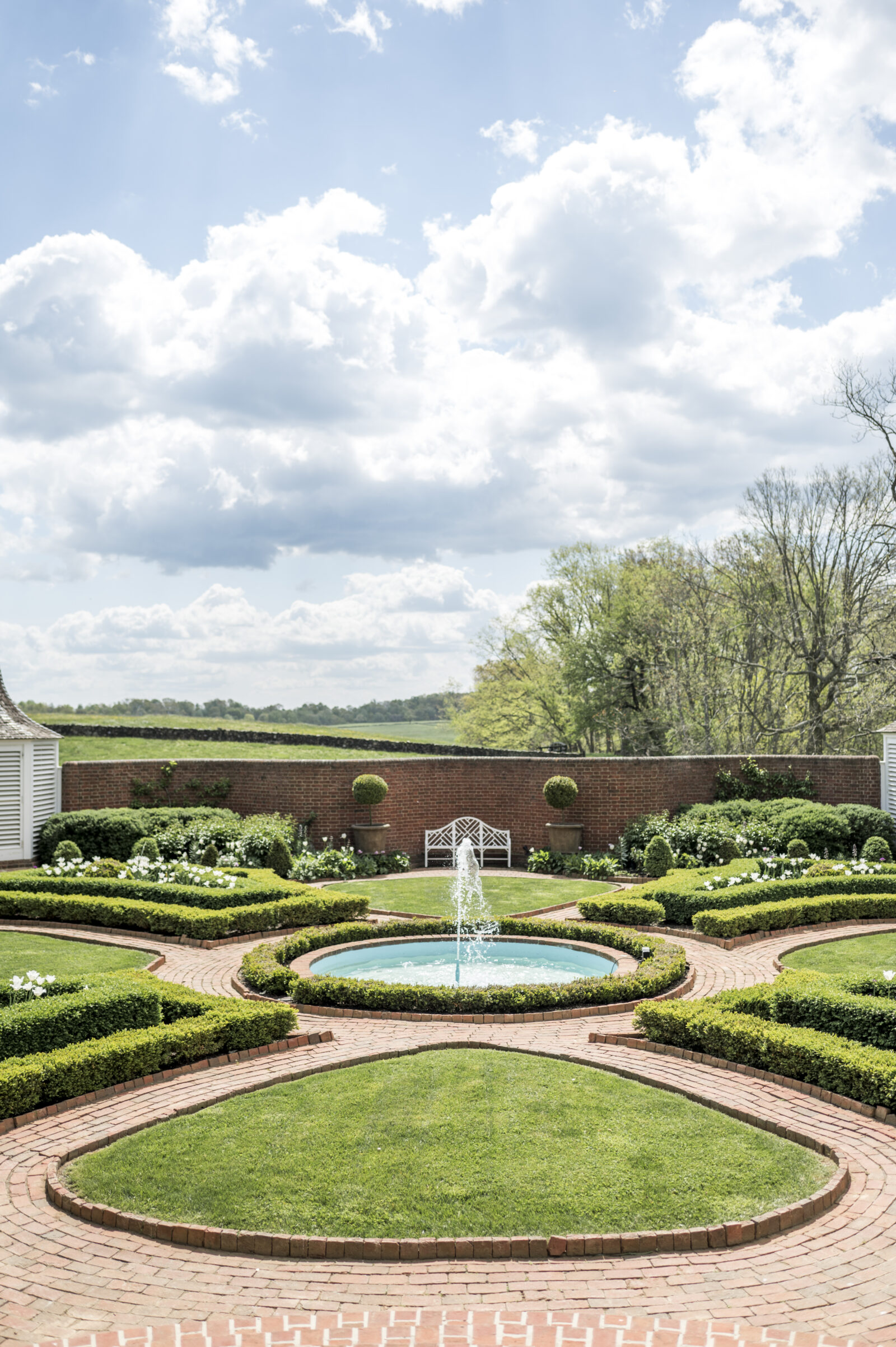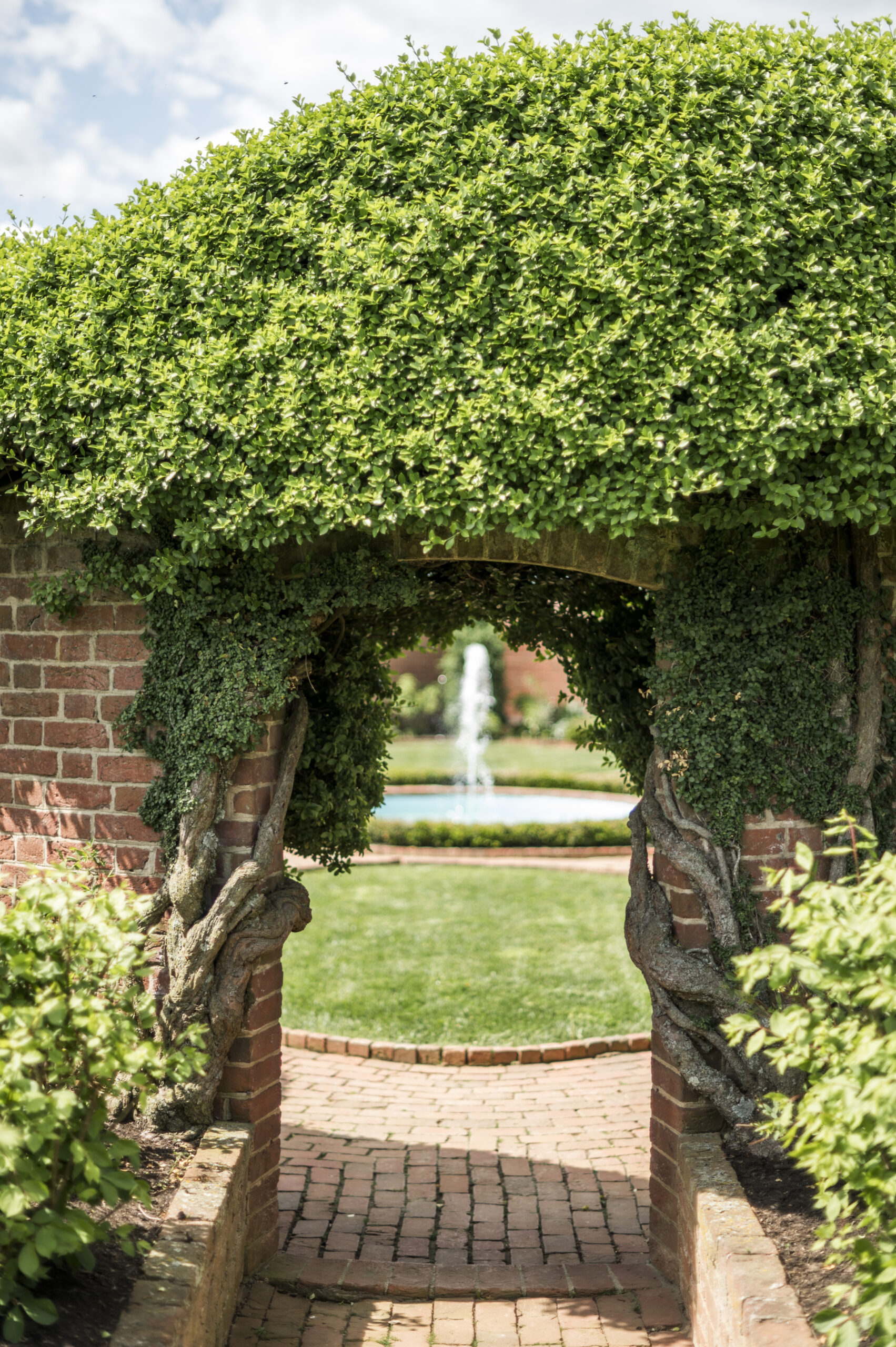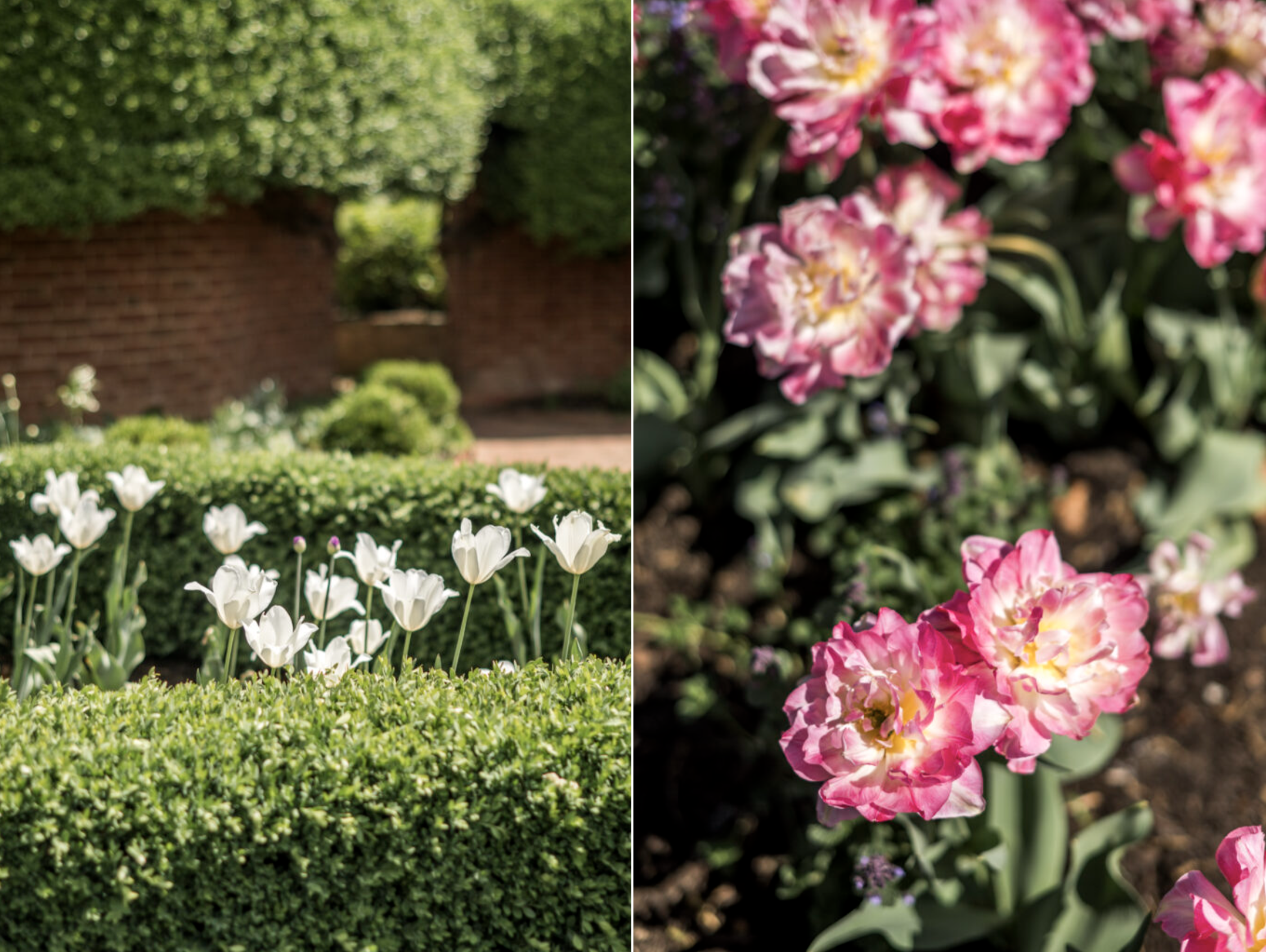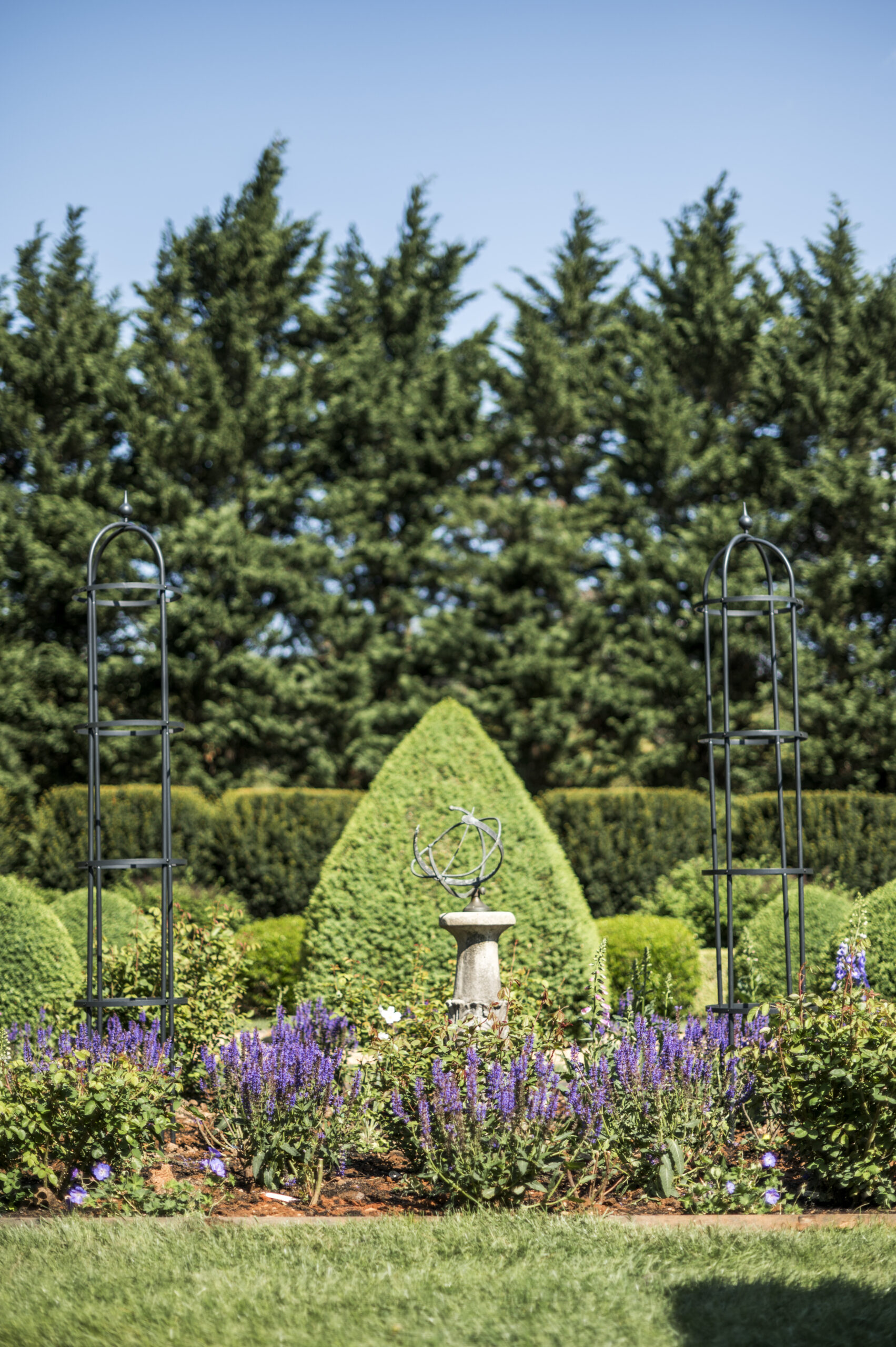English Gardens Take Root in Hunt Country

Written by Bill Kent | Photos by Gracie Savage
“English gardens are about going somewhere,” says Middleburg florist and garden designer Bridget Wilson. “You’re taken on a journey.”
The path can be cobblestone, pea gravel, or closely trimmed grass. It passes orderly, angular, precisely pruned walls of green boxwood or yew hedge, some so low that they frame the flowers, others high enough to become a maze. A few are trimmed into strange shapes, animals, and imaginary creatures. Roses soar from symmetrical pots beside a mossy freshwater spring, whose waters trickle into ponds filled with fish, frogs, and other aquatic life. Just ahead, a wildflower meadow ripples in the breeze.
“The journey brings you to a focal point,” Wilson continues. “That could be a statue, a temple, a sculpture, [or] a bench where you can sit down and take in a view.”
In the same way that Hunt Country has taken to English hunting and equestrian traditions, so do its gardens, large and small, contain elements of the English landscaping style. They are found in the exemplary gardens of Oak Spring Garden Foundation, the Oatlands Plantation, Leesburg’s Morven Park, Middleburg’s Glenstone Gardens, and at George Mason’s home of Gunston Hall in Warrenton.

When asked about what makes a garden English, Montagu “Monty” Denis Wyatt Don, host of the BBC’s “Gardeners’ World” — the most-watched gardening TV show in the English-speaking world — lists several qualities, including “a softness and prettiness that comes, I believe, partly from our climate, partly from our early industrialization which has created a cultural longing for an idealized countryside, and partly our years of colonization which flooded us with plants from all over the world.”
Don, who has visited Hunt Country and filmed a documentary about American gardens at Oak Spring, adds one more characteristic that distinguishes English gardens, in Hunt Country and throughout the world: “a carefully curated careless abandon.”
Anders Vidstrand, associate professor of horticulture at Northern Virginia Community College, agrees. “There is a whiff of eccentricity in English gardening that goes all the way back to the Tudors. The English came up with a looser, more naturalistic approach that often was anything but natural. They would move hills, redirect rivers, transplant forests, and come up with square miles of landscape that looked natural but were completely man-made. The English evolved away from that, but they never lost their taste for messing around and coming up with beautiful results.”
Colonial Williamsburg contains the earliest example in Virginia, an Anglo-Dutch hybrid that reflected the union of the English Queen Mary and the Dutch William of Orange. Joanne Chapman, Colonial Williamsburg’s landscape director, has visited many of the United Kingdom’s famous gardens, but finds the Governor’s Palace Ballroom Garden, with its 12 “apostle” topiary bushes, sharply angular planting beds, and hornbeam arbor, to be her absolute favorite. “Our 37 gardens are good examples of the geometric symmetry found in the English garden style.”
The most obvious Dutch influence are the tulips. “Tulips are much more important than their beauty,” Chapman adds. The plant was at the very center of the Dutch agricultural economy, and, because it blooms early in the spring, symbolizes new beginnings, prosperity, and love.

A garden can also have political meanings, according to British cultural historian and author Andrea Wulf. In “Founding Gardeners: the Revolutionary Generation, Nature, and the Shaping of the American Nation,” Wulf writes, “the founding fathers’ passion for nature, plants, gardens, and agriculture is woven deeply into the fabric of America and aligned with their political thought. It is impossible to understand the making of America without looking at the founding fathers as farmers and gardeners.”
Among her examples are the gardens of George Washington’s Mount Vernon, Thomas Jefferson’s Monticello, James Madison’s Montpelier, and George Mason’s Gunston Hall. Where the English surrounded their gardens with walls of brick and stone, much of the founding gardeners’ plantings are in the open. The kitchen garden, which the English used to isolate from the flower and woodland gardens, is part of the overall planting scheme, as if to say that sustenance, liberty, and beauty are intertwined.
Another gift English gardeners gave to America is the suburban lawn, once trimmed by sheep and cattle or with scythes, before the Englishman Edwin Beard Budding invented the lawn mower in 1830. About twenty years later, the English Arts & Crafts movement promoted the small, intimate cottage garden, whose featured plant was the rose, billowing in bushes and climbing up and over walls as its most vivid feature. Garden journalists such as Vita Sackville-West, Gertrude Jekyll, and William Robinson decreed that a garden was a work of art.
“I do not envy the owners of very large gardens,” Jekyll once said. “The garden should fit its owner or his or her tastes, just as one’s clothes do; it should be neither too large nor too small, but just comfortable.”
Instead of moving mountains, gardeners should let their plants follow the slope of the terrain, arranging them as a painter would combine pigments on a canvas, and create areas or “rooms” for specific varieties, effects, and growing conditions.

Hunt Country’s most astonishing example of the cottage garden style endures in the plantings Bunny Mellon created at Oak Spring. “She wasn’t afraid to try anything,” says Wilson, who restored and added to some of Mellon’s original gardens at the Brick House. “Her plantings are wild and eccentric. Whenever I go there, it’s like a revelation.”
Though gardens have existed in the British Isles since prehistoric times, what people do in them has changed remarkably.
In the 17th century, King Charles I decreed the construction of an 8-mile wall around London’s Richmond Park so he could hunt any of his 2,000 red and fallow deer whenever he chose. When commoners complained that they could not walk through the park, he ordered the placement of a single ladder. The ladder, the deer, and the park remain today, though deer hunting now happens elsewhere.
His successor, Charles II, would go for afternoon walks accompanied by his dogs in the Hampton Court gardens, a portion of which he planted with his own hands. When ministers tried to offer contrary advice, he would claim the dogs barked too loudly for him to hear.
Charles II is also famous for welcoming the first pineapple brought to British shores. This inspired the creation of an enormous, 46-foot-tall stone pineapple in the garden in Scotland’s Dunmore Park. Constructed by John Murray, the Fourth Earl of Dunmore, the sculpture commemorated the earl’s pineapple-growing hot house. The statue remains intact today, and the earl is remembered as Virginia’s last Colonial governor.
In the 20th and 21st centuries, the current King Charles III used his country house garden at Highgrove to promote environmental biodiversity, landscape sustainability, wildflower meadows, and now resilience, planting so that gardens and natural habitats can withstand the vicissitudes of climate change.
Jenn Pineau of Middleburg’s Nature Composed shares, “I have always had gardens of my own. It’s a practice that keeps me grounded to Mother Nature. My favorite thing to do in it is to lose myself in the meditation of the practice. I notice more the longer I’m out there, working with my body and digging into the natural world around me, getting curious about what I find, and honoring all that the garden produces.”
Joanne Chapman in Williamsburg, Bridget Wilson in Middleburg, and Monty Don at his garden, Longmeadow, in Herefordshire all walk through their gardens in the morning. Chapman and Wilson are usually enthralled. Don finds it frustrating.
“I always see something to do. But I do walk every inch two or three times a day trying to notice everything, trying to see everything with fresh eyes even though I know this garden as intimately as anyone ever has known a garden.
“The key to any garden and the joy of any garden,” he concludes, “is that it changes. Always. All the time. It is not the still point of the turning world I seek but the eternal flow and fluidity of life. And that comes from embracing the million tiny daily changes.” ML
Published in the May 2024 issue of Middleburg Life.








